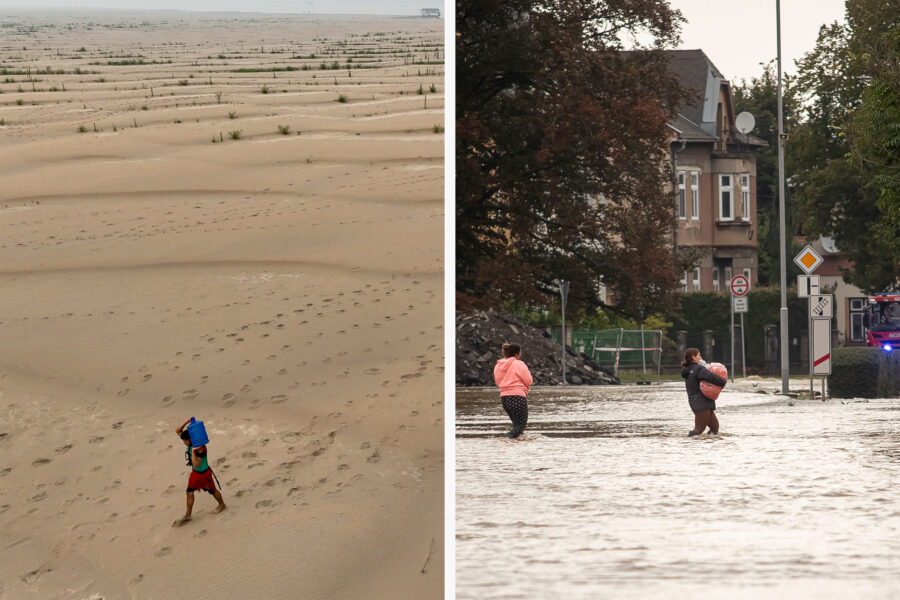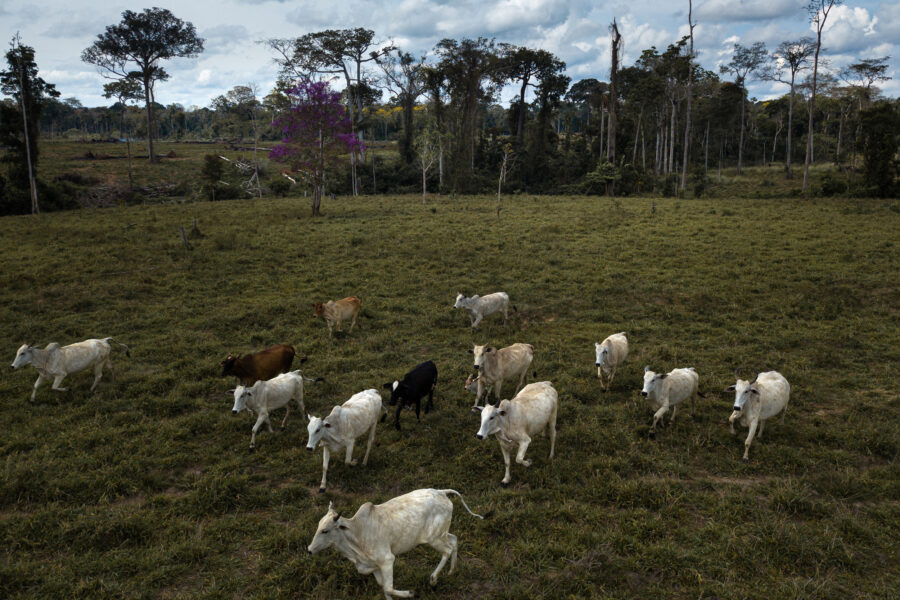A Combination of Heat and Drought Walloped Virginia Vegetable Farmers
Meteorological summer—the three hottest calendar months of the year—was the fourth hottest on record in the U.S. in 2024, with the worst of the heat in the Southwest, the Gulf Coast and the East Coast, according to a report released on Tuesday by the National Oceanic and Atmospheric Administration.
For a large section of northern and northwestern Virginia, a brutal early summer drought came with the summer heat.
Hana Newcomb has been working at Potomac Vegetable Farms at its two Virginia sites since 1980—one in the Washington, D.C., suburb of Vienna, and the other in Purcellville, about 40 miles northwest of the nation’s capital.

She said that the drought was bad enough, but the searing heat, unsurprisingly, made it worse.
“This growing season had a drought that was combined with an incredibly long hot spell, and that was the real problem—the combination of the two,” Newcomb said. “We can manage long periods with no rain, but the heat just took it out of the plants and the soil.”
The impact on the vegetables was dramatic.
“We are having a very poor tomato year because of that extreme heat in June/July,” said Newcomb. “And most farmers that I know around here say the same thing. Tomatoes, peppers and eggplant drop their blossoms when it gets extremely hot and it stays that way overnight and over many days.”
The local weather data bear that out. Not only was it the driest June on record from the Shenandoah Valley to the Tidal Potomac during that critical early summer growth period, it was also the fifth hottest, according to NOAA.
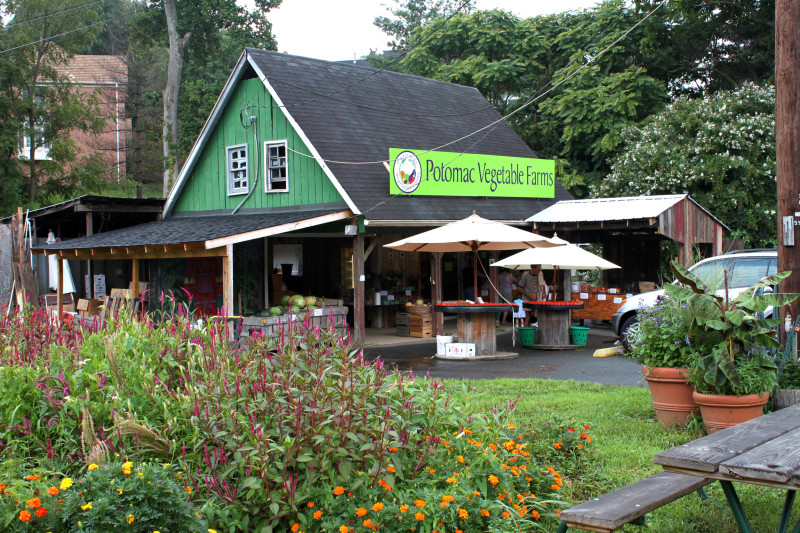
Newcomb is not alone in her observations. Ellen Polishuk co-owned and worked at Potomac Vegetable Farms for 25 years before retiring from active farming in 2017. She now consults with farmers on how to keep their operations afloat.
“We suffered with droughts like this over my whole career,” Polishuk said. “What feels different is that it is every year: that overall temperatures are higher and that rain events are fewer and stronger.”
The humid climate keeps away the far more serious droughts of California and the intermountain West. Even so, droughts do occur in Virginia, and they can develop more quickly in the warming climate. A warmer atmosphere evaporates more soil moisture, leading to rapid-onset droughts with higher impacts.
Also known as flash droughts, these droughts develop over the course of a few weeks rather than a few months, and that was the case this year. On Memorial Day, there was no trace of drought, but severe drought set in across most of Virginia west of the coastal plain by Independence Day, and it worsened to extreme drought by early August before tropical storm Debby brought some relief.
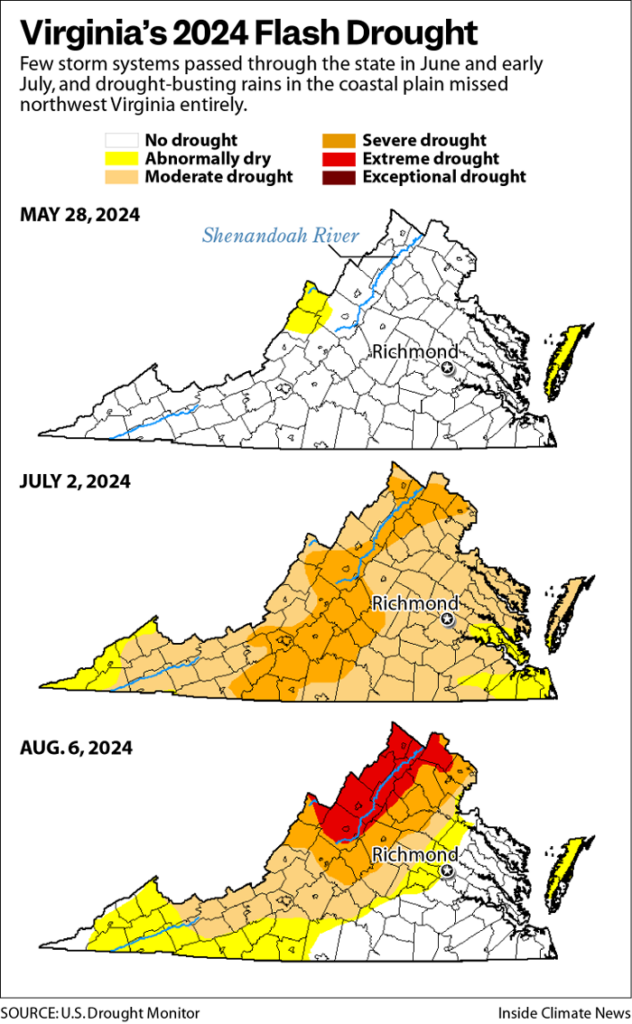
Tropical rains, however, are not the answer. Heavy rain over dry soil runs off into streams and creeks, like opening a spigot above a dried-out sponge.
Polishuk emphasizes the importance of more consistent rain. “In vegetable crop farming, we want an inch of rain (or more) a week,” she said. “So having five inches of rain one day looks good on the rainfall average chart, but is still troublesome and not good enough for food growing.”
Farther west at Fauquier Education Farm, executive director Jim Hankins emphasized how critical the June drought was, as it hit his sweet potatoes hard. “A tremendous amount of seedlings burned up in the heat—only about 10 percent survived,” he said. “Heat in August is manageable, but not in June. New seedlings cannot take it.”
All three farmers emphasized the same things concerning climate change: instability.
The data bear them out. Examining the June rainfall totals in their part of Virginia over the last 100 years shows a larger variation over the last 50 years compared to the earlier 50 years. During the more recent period, the standard deviation—a measure of how much variation there is in the data compared to average—was 1.8 inches. In the earlier period, that value was lower: 1.6 inches.
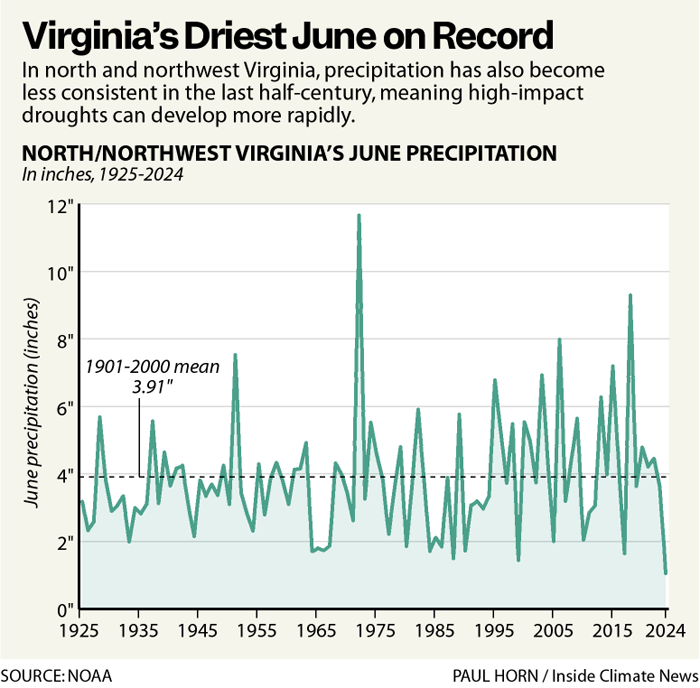
A broader examination of climate change impacts from the southeast chapter of the 2023 National Climate Assessment indicates that these types of rainfall uncertainties will continue. Flash droughts occur with higher frequency in the Southeast than in any other region of the country, and longer-term droughts appear to be increasing in severity even though they do not initially appear to be happening more often.
Irrigation is the obvious first step in managing drought, but there is no singular fix. Hankins irrigates out of nearby Turkey Creek, where a beaver dam allows the water to pool even where the rest of the creek only trickles.

“This is irrigation triage,” he said. “I plant about 10 acres, but can only irrigate one to two acres a day, then I have to move on.”
Newcomb has to dig deeper, “We have one well on the Wheatland farm in Loudoun County, and three wells that we use on the Fairfax County farm. This year we didn’t really figure out that the drought was as serious as it was—we failed to water some of the crops enough, and the plants suffered.”
Polishuk suggests additional ways to help farmers mitigate drought. Better irrigation systems are an intuitive choice, along with using mulch to hold in soil moisture. She also encourages the growth of mycorrhizal fungi, which helps plants better absorb water and nutrients from the soil.
No-till farming to keep carbon in the soil, hold moisture and decrease runoff also holds promise, but it is far from perfect. In no-till farming, farmers do not till, or plow, their fields before planting seeds, minimizing soil disturbance, which releases carbon into the atmosphere.
“Man, I have learned some stuff this year,” said Hankins, who planted half of his crop using no-till. That part of his crop survived the June drought “like it was nothing.”
His squash, melons and cantaloupe all managed well, but he remains cautious. “No-till buys some security against drought, but a good water year will probably produce a better crop using traditional methods,” he said.
Newcomb likes the idea conceptually, but is concerned that no-till can only work on a small scale. “It is incredibly labor intensive, the weed possibilities are endless, and when you take tractors out of the equation, you still have to find a way to plant and maintain crops,” he said. “We grow about 20 acres of vegetables and 10 acres of cover crop, rotated in between those vegetable crops. We try to grow as much of the cover crop using no till as we can, but if there is an established field of weeds, we till and start over.”
She offers a caution about farming, climate change and sustainability in the future.
“With the advent of supermarkets and homogenization, no one knows what is in season unless they are specifically tied to the farmers market or to a CSA (community-supported agriculture),” she said. “No one really wants to give up raspberries year round. And yet, until they do, we will not crack the code on climate change or any of the related issues. The pandemic caused a huge panic and everyone suddenly wanted to connect with a local producer. We had a great year, financially—the first year of the pandemic. But when supermarkets no longer felt scary, convenience and comfort became the deciding factor for shopping.”
Like many of her colleagues, the connection between farming and climate is obvious to her.
“Maybe that’s not specifically about climate change; that’s more about sustainability,” she said. “The two are linked.”
About This Story
Perhaps you noticed: This story, like all the news we publish, is free to read. That’s because Inside Climate News is a 501c3 nonprofit organization. We do not charge a subscription fee, lock our news behind a paywall, or clutter our website with ads. We make our news on climate and the environment freely available to you and anyone who wants it.
That’s not all. We also share our news for free with scores of other media organizations around the country. Many of them can’t afford to do environmental journalism of their own. We’ve built bureaus from coast to coast to report local stories, collaborate with local newsrooms and co-publish articles so that this vital work is shared as widely as possible.
Two of us launched ICN in 2007. Six years later we earned a Pulitzer Prize for National Reporting, and now we run the oldest and largest dedicated climate newsroom in the nation. We tell the story in all its complexity. We hold polluters accountable. We expose environmental injustice. We debunk misinformation. We scrutinize solutions and inspire action.
Donations from readers like you fund every aspect of what we do. If you don’t already, will you support our ongoing work, our reporting on the biggest crisis facing our planet, and help us reach even more readers in more places?
Please take a moment to make a tax-deductible donation. Every one of them makes a difference.
Thank you,
David Sassoon
Founder and Publisher
Vernon Loeb
Executive Editor
Share this article
Disclaimer: The copyright of this article belongs to the original author. Reposting this article is solely for the purpose of information dissemination and does not constitute any investment advice. If there is any infringement, please contact us immediately. We will make corrections or deletions as necessary. Thank you.



